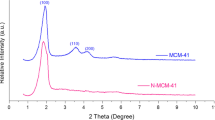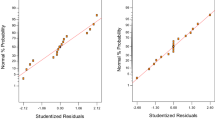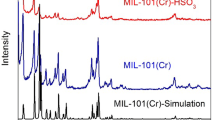Abstract
Antibiotics are emerging contaminants due to their potential risks to human health and ecosystems. Poor biodegradability makes it necessary to develop effective physical-chemical methods to eliminate these contaminants from water. The cobalt-modified MCM-41 was prepared by a one-pot hydrothermal method and characterized by SAXRD, N2 adsorption-desorption, SEM, UV–Vis DR, and FTIR spectroscopy. The results revealed that the prepared 3% Co-MCM-41 possessed mesoporous structure with BET surface areas at around 898.5 m2g−1. The adsorption performance of 3% Co-MCM-41 toward levofloxacin (LVF) was investigated by batch experiments. The adsorption of LVF on 3% Co-MCM-41 was very fast and reached equilibrium within 2 h. The adsorption kinetics followed the pseudo-second-order kinetic model with the second-order rate constants in the range of 0.00198–0.00391 g mg−1 min−1. The adsorption isotherms could be well represented by the Langmuir, Freundlich, and Dubinin-Radushkevich (D-R) isotherm equations. Nevertheless, D-R isotherm provided the best fit based on the coefficient of determination and average relative error values. The mean free energy of adsorption (E) calculated from D-R model was about 11 kJ mol−1, indicating that the adsorption was mainly governed by a chemisorption process. Moreover, the adsorption capacity was investigated as a function of pH, adsorbent dosage, LVF concentration, and temperature with help of respond surface methodology (RSM). A quadratic model was established, and an optimal condition was obtained as follows: pH 8.5, adsorbent dosage of 1 g L−1, initial LVF concentration of 119.8 mg L−1, and temperature of 31.6 °C. Under the optimal condition, the adsorption capacity of 3% Co-MCM-41 to LVF could reach about 108.1 mg g−1. The solution pH, adsorbent dosage, LVF concentration, and a combination of adsorbent dose and LVF concentration were significant factors affecting the adsorption process. The adsorption thermodynamic functions were also determined. The negative ΔH 0 (−33.50 kJ mol−1) and ΔS 0 (−43.57 J mol−1 K−1) suggested that the adsorption was an exothermic process accompanied by decreasing disorder. This study may indicate that 3% Co-MCM-41 is a promising adsorbent for removing emerging pollutants of LVF from water.









Similar content being viewed by others
References
Alam JB, Dikshit AK, Bandyopadhayay M (2005) Evaluation of thermodynamic properties of sorption of 2,4-D and atrazine by tire rubber granules. Sep Purif Technol 42:85–90
Ali I (2010) The quest for active carbon adsorbent substitutes: inexpensive adsorbents for toxic metal ions removal from wastewater. Sep Purif Rev 39:95–171
Ali I (2012) New generation adsorbents for water treatment. Chem Rev 112:5073–5091
Ali I (2014) Water treatment by adsorption columns: evaluation at ground level. Sep Purif Rev 43:175–205
Ali I, Aboul-Enein HY (2004) Chiral pollutants: distribution, toxicity and analysis by chromatography and capillary electrophoresis. John Wiley & Sons, Chichester
Ali I, Asin M, Khan TA (2012) Low cost adsorbents for the removal of organic pollutants from wastewter. J Environ Manag 113:170–183
Amini M, Younesi H, Bahramifar N (2009) Biosorption of nickel(II) from aqueous solution by Aspergillus niger: response surface methodology and isotherm study. Chemosphere 75:1483–1491
Azzaz AA, Jellali S, Akrout H, Assadi AA, Bousselmi L (2016) Optimization of a cationic dye removal by a chemically modified agriculture by-product using response surface methodology: biomasses characterization and adsorption properties. Environ Sci Pollut Res. doi:10.1007/s11356-016-7698-6
Benhamou A, Baudu M, Derriche Z, Basly JP (2009) Aqueous heavy metals removal on amine-functionalized Si-MCM-41 and Si-MCM-48. J Hazard Mater 171:1001–1008
Brain RA, Johnson DJ, Richards SM, Sanderson H, Sibley PK, Solomon KR (2004) Effects of 25 pharmaceutical compounds to Lemna gibba using a seven-day stastic-renewal test. Environ Toxicol Chem 23:371–382
Carabineiro SAC, Thavorn-Amornsri T, Pereira MFR, Figueiredo JL (2011) Adsorption of ciprofloxacin on surface-modified carbon materials. Water Res 45:4583–4591
Chatterjee M, Ishizaka T, Kawanami H (2014) Preparation and characterization of PdO nanoparticles on trivalent metal (B, Al and Ga) substituted MCM-41: excellent catalytic activity in supercritical carbon dioxide. J Colloid Interf Sci 420:15–26
Chen W, Li X, Pan Z, Bao Y, Ma S, Li L (2015) Efficient adsorption of norfloxacin by Fe-MCM-41 molecular sieves: kinetic, isotherm and thermodynamic studies. Chem Eng J 281:397–403
de Luna MDG, Flores ED, Genuino DAD, Futalan CM, Wan M-W (2013) Adsorption of eriochrome black T (EBT) dye using activated carbon prepared from waste rice hulls—optimization, isotherm and kinetic studies. J Taiwan Inst Chem Eng 44:646–653
Dimos K, Stathi P, Karakassides MA, Deligiannakis Y (2009) Synthesis and characterization of hybrid MCM-41 materials for heavy metal adsorption. Micropor Mesopor Mater 126:65–71
Djurdjevic P, Milenajelikic-Stankov, Lazarevic L (2001) The effect of surfactants on equilibria in aluminium (III) ion + ofloxacin solution and adsorption of ofloxacin on aluminium - oxide. Bull Chem Soc Jpn 74:1261
Dodd MC, Shah AD, Gunten UV, Huang C (2005) Interactions of fluoroquinolone antibacterial agents with aqueous chlorine: reaction kinetics, mechanisms, and transformation pathways. Environ Sci Technol 39:7065–7076
Goyne KW, Chorover J, Kubicki JD, Zimmerman AR, Brantley SL (2005) Sorption of the antibiotic ofloxacin to mesoporous and nonporous alumina and silica. J Colloid Interf Sci 283:160–170
Gu C, Karthikeyan KG (2005) Sorption of the antimicrobial ciprofloxacin to aluminum and iron hydrous oxides. Environ Sci Technol 39:9166–9173
Gu G, Ong PP, Chu C (1999) Thermal stability of mesoporous silica molecular sieve. J Phys Chem Solids 60:943–947
Halling-Sorensen B, Nielsen NS, Lanzky PF, Ingerslev F, Liitzhofl HCH, Jorgensen SE (1998) Occurrence, fate and effects of pharmaceutical substances in the environment - a review. Chemosphere 36:357–393
Hartmann A, Alder AC, Koller T, Widmer RM (1998) Identification of fluoroquinolone antibiotics as the main source of umuc genotoxicityin native hospital wastewater. Environ Toxicol Chem 17:377–382
Ho YS, McKay G (1999) Pseudo-second order model for sorption processes. Process Biochem 34:451–465
Ho KY, McKay G, Yeung KL (2003) Selective adsorbents from ordered mesoporous silica. Langmuir 19:3019–3024
Jung C, Son A, Her N, Zoh K-D, Cho J, Yoon Y (2015) Removal of endocrine disrupting compounds, pharmaceuticals, and personal care products in water using carbon nanotubes: a review. J Ind Eng Chem 27:1–11
Kim J-W, Jang H-S, Kim J-G, Ishibashi H, Hirano M, Nasu K, Ichikawa N, Takao Y, Shinohara R, Arizono K (2009) Occurrence of pharmaceutical and personal care products (PPCPs) in surface water from Mankyung river, South Korea. J Health Sci 55:249–258
Kumar R, Bishnoi NR, Garima, Bishnoi K (2008) Biosorption of chromium(VI) from aqueous solution and electroplating wastewater using fungal biomass. Chem Eng J 135:202–208
Li Z, Hong H, Liao L, Ackley CJ, Schulz LA, MacDonald RA, Mihelich AL, Emard SM (2011) A mechanistic study of ciprofloxacin removal by kaolinite. Colloids Surf B 88:339–344
Li A, Pi S, Wei W, Chen T, Yang J, Ma F (2016) Adsorption behavior of tetracycline by extracellular polymeric substrates extracted from Klebsiella sp. J Environ Sci Pollut Res. doi:10.1007/s11356-016-7726-6
Lim S, Ciuparu D, Pak C, Dobek F, Chen Y, Harding D, Pfefferle L, Haller G (2003) Synthesis and characterization of highly ordered Co-MCM-41 for production of aligned single walled carbon nanotubes (SWNT). J Phys Chem B 107:11048–11056
Liu Y, Dong C, Wei H, Yuan W, Li K (2015) Adsorption of levofloxacin onto an iron-pillared montmorillonite (clay mineral): kinetics, equilibrium and mechanism. Appl Clay Sci 118:301–307
Martins AR, Salviano AB, Oliveira AA, Mambrini RV, Moura FC (2016) Synthesis and characterization of catalysts based on mesoporous silica partially hydrophobized for technological applications. Environ Sci Pollut Res. doi:10.1007/s11356-016-6692-3
Masson S, Vaulot C, Reinert L, Guittonneau S, Gadiou R, Duclaux L (2016) Thermodynamic study of seven micropollutants adsorption onto an activated carbon cloth: Van’t Hoff method, calorimetry, and COSMO-RS simulations. Environ Sci Pollut Res. doi:10.1007/s11356-016-7614-0
Nowara A, Burhenne J, Spiteller M (1997) Binding of fluoroquinolone carboxylic acid derivatives to clay minerals. J Agric Food Chem 45:1459–1463
Paul T, Miller PL, Strathmann TJ (2007) Visible-light-mediated TiO2 photocatalysis of fluoroquinolone antibacterial agents. Environ Sci Technol 41:4720–4727
Paul T, Dodd MC, Strathmann TJ (2010) Photolytic and photocatalytic decomposition of aqueous ciprofloxacin: transformation products and residual antibacterial activity. Water Res 44:3121–3132
Peng H, Pan B, Wu M, Liu R, Zhang D, Wu D, Xing B (2012) Adsorption of ofloxacin on carbon nanotubes: solubility, pH and cosolvent effects. J Hazard Mater 211-212:342–348
Perini JAL, Silva BC, Tonetti AL, Nogueira RFP (2016) Photo-Fenton degradation of the pharmaceuticals ciprofloxacin and fluoxetine after anaerobic pre-treatment of hospital effluent. Environ Sci Pollut Res. doi:10.1007/s11356-016-7416-4
Punyapalakul P, Sitthisorn T (2010) Removal of ciprofloxazin and carbamazepine by adsorption on functionalized mesoporous silicates. World Acad Sci Eng Technol 69:546–550
Qi F, Chu W, Xu B (2013) Catalytic degradation of caffeine in aqueous solutions by cobalt-MCM41 activation of peroxymonosulfate. Appl Catal B 134-135:324–332
Robinson AA, Belden JB, Lydy MJ (2005) Toxicity of fluoroquinolone antibiotics toaquatic organisms. Environ Toxicol Chem 24:423–430
Roosta M, Ghaedi M, Asfaram A (2015) Simultaneous ultrasonic-assisted removal of malachite green and safranin O by copper nanowires loaded on activated carbon: central composite design optimization. RSC Adv 5:57021–57029
Serna-Galvis EA, Giraldo-Aguirre AL, Silva-Agredo J, Florez-Acosta OA, Torres-Palma RA (2016) Removal of antibiotic cloxacillin by means of electrochemical oxidation, TiO2 photocatalysis, and photo-Fenton processes: analysis of degradation pathways and effect of the water matrix on the elimination of antimicrobial activity. Environ Sci Pollut Res. doi:10.1007/s11356-016-6257-5
Sharma VK (2008) Oxidative transformations of environmental pharmaceuticals by Cl2, ClO2, O3, and Fe(VI): kinetics assessment. Chemosphere 73:1379–1386
Shi S, Fan Y, Huang Y (2013) Facile low temperature hydrothermal synthesis of magnetic mesoporous carbon nanocomposite for adsorption removal of ciprofloxacin antibiotics. Ind Eng Chem Res 52:2604–2612
Van Doorslaer X, Dewulf J, Van Langenhove H, Demeestere K (2014) Fluoroquinolone antibiotics: an emerging class of environmental micropollutants. Sci Total Environ 500-501:250–269
Venezia AM, Murania R, Pantaleo G, La Parola V, Scirè S, Deganello G (2009) Combined effect of noble metals (Pd, Au) and support properties on HDS activity of Co/SiO2 catalysts. Appl Catal A 353:296–304
Wei H, Hu D, Su J, Li K (2015) Intensification of levofloxacin sono-degradation in a US/H2O2 system with Fe3O4 magnetic nanoparticles. Chinese J Chem Eng 23:296–302
Witte BD, Langenhove HV, Hemelsoet K, Demeestere K, Wispelaere PD, Van Speybroeck V, Dewulf J (2009) Levofloxacin ozonation in water: rate determining process parameters and reaction pathway elucidation. Chemosphere 76:683–689
Wu Q, Li Z, Hong H, Yin K, Tie L (2010) Adsorption and intercalation of ciprofloxacin on montmorillonite. Appl Clay Sci 50:204–211
Xiao X, Zeng X, Lemley AT (2010) Species-dependent degradation of ciprofloxacin in a membrane anodic Fenton system. J Agric Food Chem 58:10169–10175
Xu X, Wu J, Xu W, He M, Fu M, Chen L, Zhu A, Ye D (2016) High-effficiency non-thermal plasma-catalysis of cobalt incorporated meosoporous MCM-41 for toluene removal. Catal Today. doi:10.1016/j.cattod.2016.03.036
Zhang C, Li B, Wang Y (2010) Adsorption of norfloxacin from aqueous solution onto modified coal fly ash. Chem Eng Technol 33:969–972
Zhao Q, Xu Y, Li Y, Jiang T, Li C, Yin H (2009) Effect of the Si/Ce molar ratio on the textural properties of rare earth element cerium incorporated mesoporous molecular sieves obtained room temperature. Appl Surf Sci 255:9425–9429
Acknowledgements
The authors gratefully acknowledge the financial supports from NFFTBS (No. J1103311 and No. J1210057) and Open Funding Project of State Key Laboratory Base of Eco-Hydraulic Engineering in Arid Area, Xi’an University of Technology (No. 2016KFKT-3).
Author information
Authors and Affiliations
Corresponding author
Additional information
Responsible editor: Guilherme L. Dotto
Electronic supplementary material
ESM 1
(DOC 203 kb)
Rights and permissions
About this article
Cite this article
Jin, T., Yuan, W., Xue, Y. et al. Co-modified MCM-41 as an effective adsorbent for levofloxacin removal from aqueous solution: optimization of process parameters, isotherm, and thermodynamic studies . Environ Sci Pollut Res 24, 5238–5248 (2017). https://doi.org/10.1007/s11356-016-8262-0
Received:
Accepted:
Published:
Issue Date:
DOI: https://doi.org/10.1007/s11356-016-8262-0




